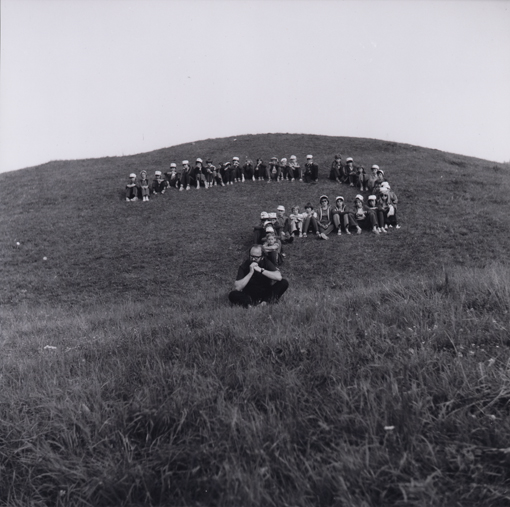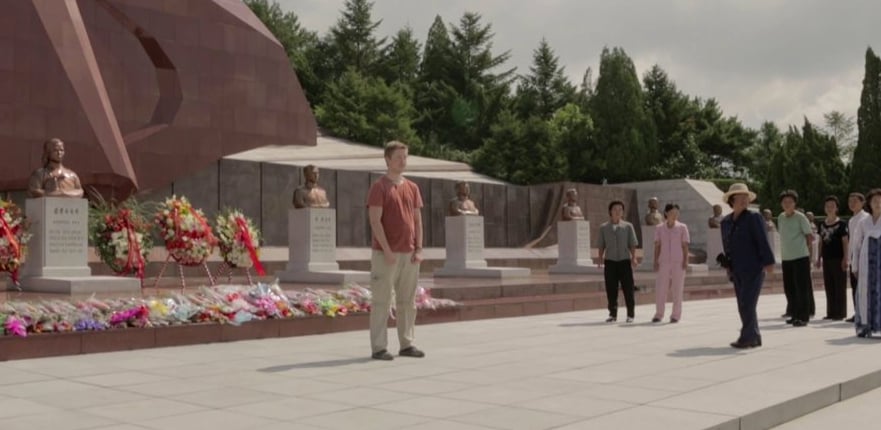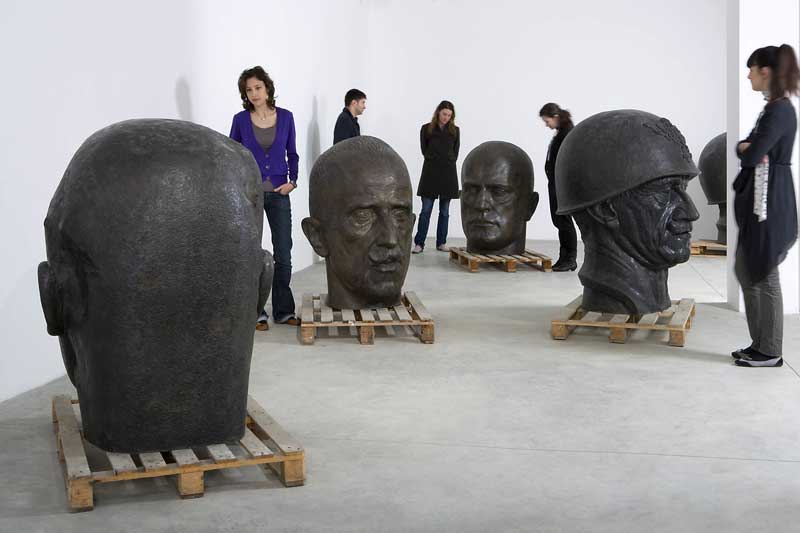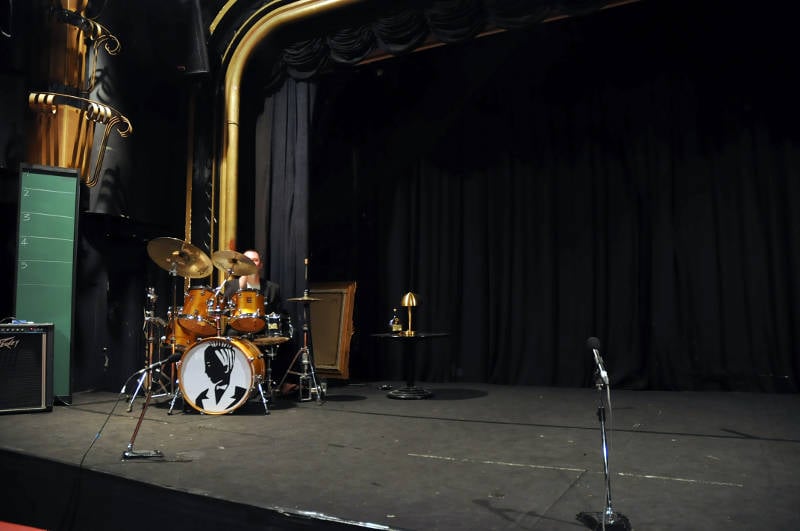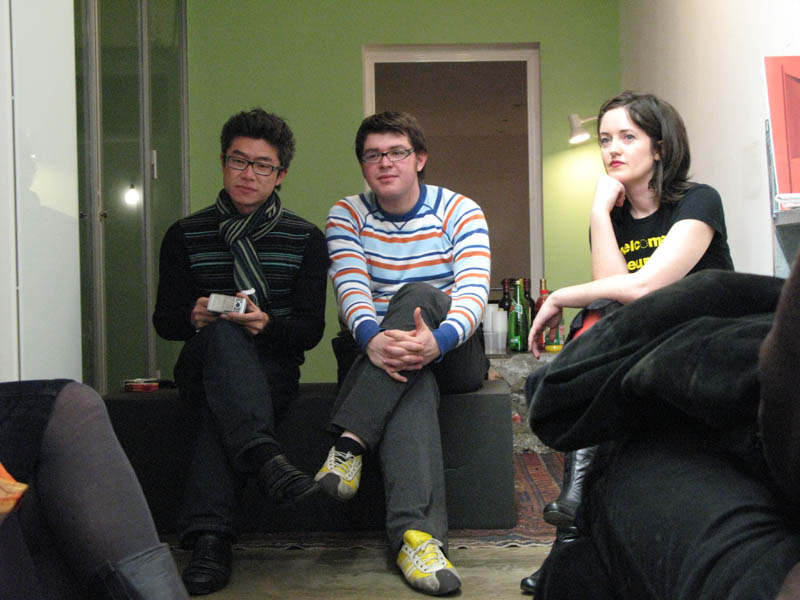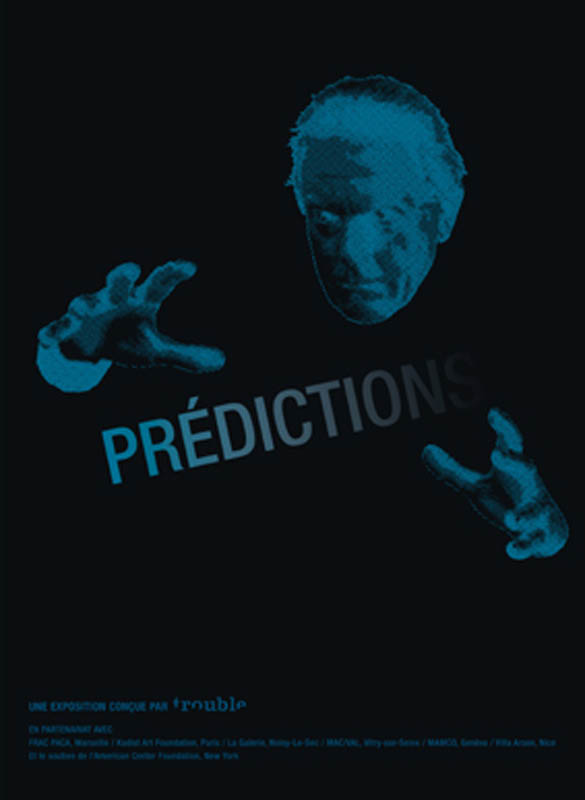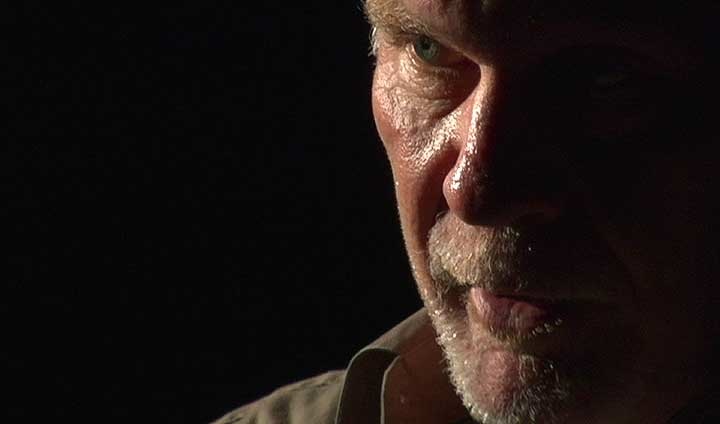
© » KADIST
Shen Xin
Composed of five episodes, Brine Lake (A New Body) by Shen Xin is set in a fictional factory where iodine is produced as a byproduct of natural gas sourced from deep sea brine lakes. Korean, Japanese, and Russian are spoken in multiple episodes. The protagonists have multiple encounters and conversations with two unseen employees of the factory whose visions are overtaken by the camera.

© » KADIST
Connie Zheng
The Lonely Age by Connie Zheng is the first chapter in a trilogy of short experimental films about the complex temporalities of navigating ongoing environmental crises, as seen through the lens of seeds real and imagined. The film is set in a highly toxic and ecologically ravaged near future, in which people begin to hear rumors of seeds that have washed up on the shores of California after escaping from a factory in China. The seeds are rumored to possess curative properties, but they are also said to be sentient.

© » KADIST
Andrew Norman Wilson
Z = |Z/Z•Z-1 mod 2|-1: Lavender Town Syndrome by Andrew Norman Wilson is a multi-channel video that uses three different imaging technologies—a photographic lens, photorealistic ray tracing animations, and fractal ray-marching animations—to travel through three constructed environments. The work’s subtitle, Lavender Town Syndrome, is named for a conspiracy theory in which more than 200 Japanese children were driven to suicide by a particular board in the game Pokémon Red and Green for Game Boy. Many others suffered serious migraines or nosebleeds, or turned violent when their parents tried to take the game away.

© » KADIST
Nazgol Ansarinia
In the early 2000s, as urban redevelopment accelerated and intense construction significantly diminished public space in Tehran, state-funded murals began to represent imaginary landscapes on building facades. The municipality of Tehran uses such pictorial representation to to exert influence over and come to terms with the flow of communal desire. The protrusion of the unreal onto the real interrupts the values, independence, and functionality of one over the other.

© » KADIST
Andrew Norman Wilson
In Andrew Norman Wilson’s work Kodak the artist uses computer-generated imagery to create narratives that question the reliability of images in the age of post-production. The artist creates disturbances in typical notions of time and space to highlight the existential terror of humans trying to make sense of their memories and perception in the 21st century. On its surface, Kodak questions how improvements in digital imagery have affected the analog film industry, but it also showcases the consequences for how humans relate to their memories.

© » KADIST
Sung Hwan Kim
An early work in Sung Hwang Kim’s career, the video Summer Days in Keijo—written in 1937 is a fictional documentary, the film is based on a non-fiction travelogue, In Korean Wilds and Villages , written by Swedish zoologist Sten Bergman, who lived in Korea from 1935 to 1937. In Kim’s film, a Dutch female protagonist traces Bergman’s path in the present-day Seoul (Keijo was the Japanese name for Gyeongseong, currently Seoul). The protagonist navigates through spaces that have been rebuilt since the 1950s onwards, and the scenes are narrated by a voice-over based on Bergman’s written description of the modern city in 1937.

© » KADIST
Matt Mullican
Drawing & Print (Drawing & Print)
Mullican’s Stick Figure Drawings depict characters reduced to their most basic graphic representation. Glen is a simple silhouette, genderless and inspired by a found photo of a crime scene, in whom we recognize the generic sign of the universal symbol of a self-portrait. Mullican continually projects himself, sometimes physically, into the silhouette that he has created, allowing the artist to pass from one reality to another.

© » KADIST
Karthik Pandian
Filmed in Morocco, the film Atlas by Karthik Pandian continues his investigation into history, site and monument. The film explores fundamental notions of movement, freedom and the cinematic imaginary through the figure of the camel. Rather than focusing on the Moroccan patrimonial landscape, which is itself full of simulations and fantasies conjured for the touristic imagination, Pandian shot the video in Ouarzazate, Hollywood’s go-to location to stage the desert — from Lawrence of Arabia to The Mummy.

© » KADIST
Clemens von Wedemeyer
Clemens von Wedemeyer has imagined a trip back in time at Breitenau. Starting with events that happened there from 1933 to 1945, the German artist has composed three stories that reach the years of the women’s reformatory, in the 1970s, with a different protagonist for each era. A work that attempts to bring out the “pathology” of the site, as the artist tells Bert Rebhandl, and at the same time its “unforgettable” status as a black hole in the history of Germany, that sucked up innocent lives for almost a century.

© » KADIST
Bady Dalloul
Bady Dalloul’s Scrapbook is a 48 minute video beginning from his birth, tracing major global events of the 20 th century, including the beginning and current Occupation and colonization of Palestine, the atomic bombings of Hiroshima and Nagasaki, assassination of family members and the Syrian diaspora. A voice over follows these moments as the camera traces over the collage that includes text; photos; postcards; origami birds; and inserted videos of world leaders. The film is a letter to the viewer, imploring the witnessing of what we assume, but cannot know, to be the artist speaking.

© » KADIST
TU Pei-Shih
Making Fantasies animates scenes based upon photographs by Nan Goldin, Larry Sultan, Richard Billingham, Yasuyoshi Chiba and famous photojournalism images such as Jeff Widener’s photograph of Tiananmen Square and Kevin Carter’s photograph of a Sudanese child being stalked by a vulture. By fabricating narrative and aesthetic connections between the images on three channels, Pei-Shih questions the objectivity and truth telling of photography.

© » KADIST
Mary Helena Clark
By testing the limits of identification with the camera’s point of view, Delphi Falls cycles through multiple subjectivities. The film misuses more traditional narrative conventions -the suggestion of a story, the anchoring of actors as characters- to have the viewer constantly questioning who or what they are, and where they are located in the film’s world. Delphi Falls was included in the 2017 Whitney Biennial film program.

© » KADIST
Nicolás Grum
El gran pacto de Chile (The Great Pact) and La balserita de Puerto Gala (The Raft) were part of the “Museo Futuro”, an exhibition in which the artist presented nine miniature dioramas staging fragments of Chile’s history, from its colonial invasions to the present. Through the episodes he chose to depict, the artist focused on historical narratives, the way the story is told, and the supposed irrefutability of historical facts. Museo Futuro (“Future Museum”) stands within a tradition of artists who re-read history and offer their interpretation of it through the distopic lens of the museum display.

© » KADIST
Mary Reid Kelley
Kelley’s 2015 portrait of the poet Charles Baudelaire is one of a series of poets, rappers, and other thinkers who have influenced the artist’s ideas about beauty, creativity, and expression. As a challenging artist who marches to her own drum, Mary Reid Kelley is in the vanguard of a generation that blends the digital and the analog to dialogue with history. From 2009 to the present, she has made videos that fuse live performance, animation, drawing, sculpture, and digital design.
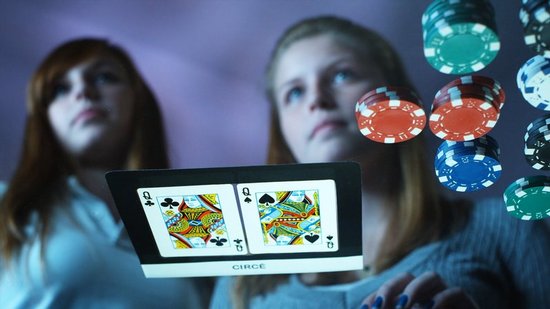
© » KADIST
Olive Martin and Patrick Bernier
The Mohawk, the emblematic Frontier river in the period of American colonisation, is here a cable of data transmission, and the 7 Sultans Casino is a virtual destination, one of the three hundred online casinos hosted by the servers located in Kahnawake, a small native american indian reserve to the south of Montreal. Incorporating poker, challenges to the law, a struggle for the control of a new territory where the stakes are high, our film ‘La Nouvelle Kahnawake’, between fiction and documentary, pushes these analogies with the Western to explore both our relationship to the figure of the ‘Indian’ and the confusion of our perception of space that new information technology has brought about. As the artists state: “We are neither anthropologists nor journalists.
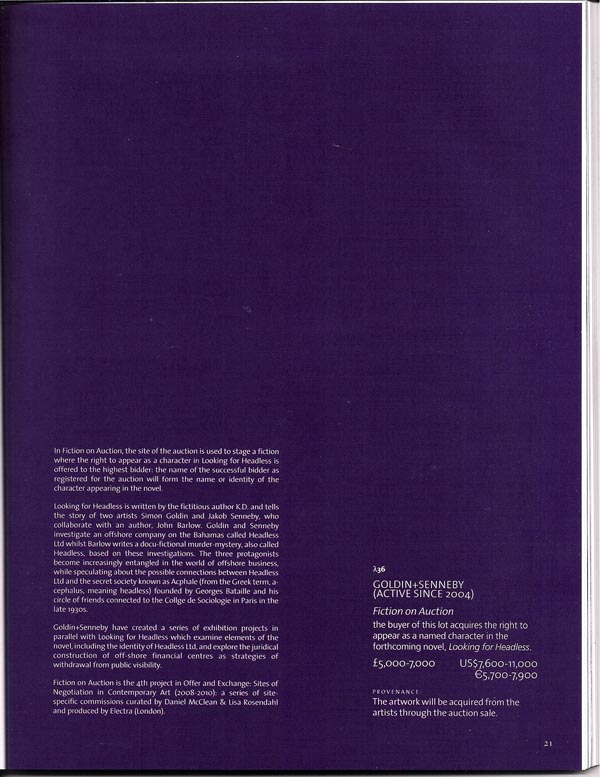
© » KADIST
Goldin+Senneby
In Fiction on Auction , the site of the auction is used to stage a fiction where the right to appear as character in Looking for Headless is offered to the highest bidder: the name of the successful biddder as registered for the auction will form the name or identity of the character appearing in the novel. Looking for Headless is written by the fictitious author K. D and tells the story of two artists Simon Goldin and Jakob Senneby who collaborate with an author, John Barlow. Goldin and Senneby investigate an offshore company on the Bahamas called Headless Ltd whilst Barlow writes a docu-fictional murder-mystery, also called Headless, based on these investigations.

© » KADIST
Wong Kit Yi
Artist Wong Kit Yi’s A River in the Freezer combines directed and found footage to meditate upon glacial memory, cryogenics, and frozen fiction. She synthesizes disparate subjects—ranging from Longyearbyen, Norway (a town where no one is allowed to die), the fair-haired manga character Cygnus Hyoga, 19th-century global trading in ice, and color wavelength theory, among others—within a karaoke-inspired sing-along format.

© » KADIST
Valérie Jouve
Like many contemporary photographers who play with the codes of realism, Valérie Jouve composes her images, having already a more or less predetermined result in mind, in order to deliver a complex representation of the world instead of a bold presentation of facts. A part of the series “Les Figures”, this “portrait’ of P. Faure carries a strong ambiguity, typical of the photographer’s images, between realism and mise-en-scene . This photograph is exemplary of Valérie Jouve’s work: inscription of an inidual within an urban landscape, relation to architecture, simplicity of composition and strong, yet imprecise narrativity – related in part to seemingly familiar characters or places.

© » KADIST
Xolo Cuintle
In a post-apocalyptic setting, a layer of dust petrifies everything in an eternal state of latency. Thick as it is, a rocking chair becomes imponent and can no longer rock. The growth of vegetation has been hampered by concrete and could be mistaken for rocks.

© » KADIST
Goldin+Senneby
In this installation, you are standing at the heart of a bicephalous space reflecting Goldin+Senneby’s main research led during their residency in Paris. Here, two historical events from the late 1930’s and early 50’s are confronted. In one of these spaces, you find yourself reading a map of the Marly forest where Georges Bataille’s secret society, « Acéphale », was meeting around 1937 and notably celebrating Louis XVI’s regicide.

© » KADIST
Subash Thebe Limbu
In Ningwasum , Subash Thebe Limbu explores Adivasi Futurism, a concept he has developed over a number of years, inspired by the writings of Octavia Butler, Afrofuturism, Indigenous Futurism, and various Adivasi, Janajati, feminist, queer, and Dalit movements. The video features an Indigenous, astronaut time traveller from the future, whose Indigenous nation not only co-exists with other nations and allies but also contains advanced technology that would appear magical to those from the present. Filmed mostly in the Himalayas, including the Wasanglung region in Eastern Nepal believed to be the shamanic home of the Yakthung, Ningwasum weaves oral narratives, animations, language, storytelling, soundscapes, and electronic music.

© » KADIST
Yin-Ju Chen
Through a semi-fictional approach, Extrastellar Evaluations envisions a version of history in which alien inhabitants, the Lemurians, lived among humans under the guise of various renowned conceptual and minimal artists in the 1960s (Carl Andre, Mel Bochner, and James Turrell to name a few). If humans interpreted and appropriated the geometric-shaped works they created as conceptual and minimalist artworks, the objects were in fact transmission devices the Lemurians used to report back on human actions to their mother planet. The video takes the form of a channeled message from Adama, High Priest and spiritual leader of the Lemurians.

© » KADIST
Philip-Lorca diCorcia
For this series, Philip-Lorca diCorcia walked along Santa Monica Boulevard in Los Angeles in search of models who would be prepared to pose in hotel rooms according to pre- planned scenarios. The artist explained that: “I went back to the street just like the ordinary clients of these prostitutes. I went up to them and mentioned the following: ‘I would like to take a photo of you, I will pay you exactly what you are paid for a pass’”.

© » KADIST
Anton Vidokle
Shot in Oliveto Lucano, a village in the south of Italy, AUTOTROFIA (meaning self-eating) by artist Anton Vidokle is a cinéma vérité style film that slides fictive characters into real situations, and vice-versa, to draw a prolonged meditation on the cycle of life, seasonal renewal, and ecological awareness. Combining fictional and non-fictional content, the film slips an interpretative script based on the writings of the painter Vassily Chekrygin, and the scientist Vladimir Vernadsky, within the context of an ancient pagan fertility ritual still practiced in the region. The film’s impressionistic plot revolves around the ecological dimensions of Russian Cosmism.
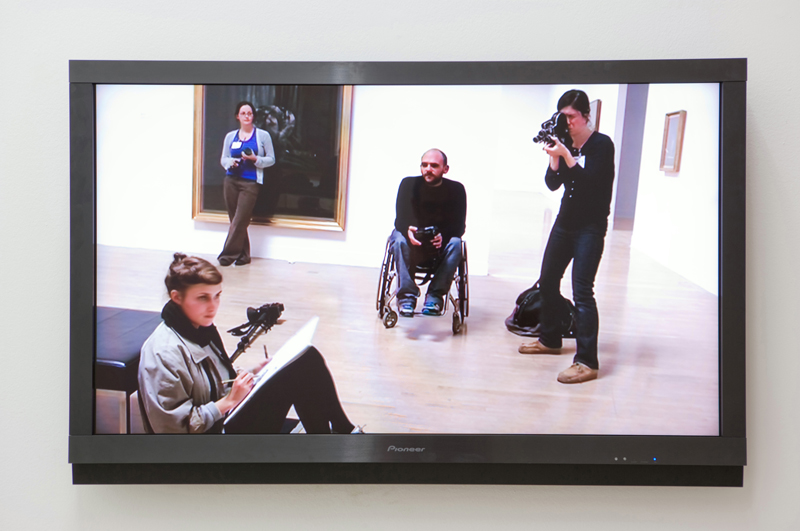
© » KADIST
Ryan Gander
The work consists of a work inside a work. The spectator is presented with a commissioned documentary on a flat-screen Tv on the subject of the production of the making of an artwork that doesn’t exist entitled The magic and the meaning (2008). The imaginary film, The magic and the meaning , is described only within the documentary, which follows parts of the making of the film, extracts from interviews with the writer and film maker Dan Fox and the artist and maker of the work Ryan Gander; as well as showing short slow-motion sections of the film that does not exist.

© » KADIST
Julius Koller
Wordplay was a central focus of Koller’s work, in particular the acronym U. F. O, which he adapted in his diagrammatic drawings to stand variously for Univerzálna Futurologická Organizácia (Universal Futurological Organization, 1972–3), Univerzálny Filozoficky Ornament (Universal Philosophical Ornament, 1978) or Underground Fantastic Organization (1975), and which also appeared in a series of slapsticky self-portraits titled ‘U. F. O.–naut’ (1970–2007). These infinite variations on a common cipher constituted an insistent incantation of the Utopian principle.

© » KADIST
Omer Fast
“Watching the films of Omer Fast confounds our expectations of the medium. 5,000 Feet Is the Best, 2011, is presented like a conventional big-budget Hollywood movie and has similarly high production values. Yet Fast frustrates the narrative element that Hollywood teaches us to expect: While stories unfold, repetitions and obscurities challenge the idea of a central controlling account.

© » KADIST
Keren Cytter
“Untitled” is inspired by the movie “Opening Night” by John Cassavetes with Gena Rowlands playing the role of a fallen woman, anguished by her distressed life. In the film, we witness the drama of a blended family, heightened by adultery and finally murder. For the film’s decor, Cytter, instead of filming a domestic interior, uses a theater stage, a place of representation by excellence.

© » KADIST
Elisheva Biernoff
In her recent work, Biernoff is interested in investigating fictions and fantasies embedded in the remnants of consumer culture (for example magazines) or through ephemera such as postcards and old photographs. Although the imagery present in her work might seem nostalgic upon first encounter, Biernoff’s complex tableaux often reveal the artist’s skeptical look towards her subjects matters. They Were Here (2010), constitutes a clear example.

© » KADIST
Mariana Castillo Deball
Taking archaeology as her departure point to examine the trajectories of replicated and displaced objects, “Who will measure the space, who will tell me the time?” was produced in Oaxaca for her exhibition of the same title at the Contemporary Museum of Oaxaca (MACO) in 2015. The sculpture, employing the technique of traditional Atzompa pottery originating from Oaxaca, Mexico, is an examination of the way in which archaeological heritage is remembered in the earthenware made by Atzompa potters today. Accompanied by the publication ‘Ixiptla Vol.
Goldin+Senneby
Since 2004, the artists Goldin+Senneby, comprised of Simon Goldin and Jakob Senneby, have been working on an ongoing performative and rhizomatic project...
Andrew Norman Wilson
Andrew Norman Wilson is an artist, curator, and filmmaker whose practice is mostly based in research and documentary...
Shen Xin
Shen Xin’s practice examines how emotion, judgment, and ethics are produced and articulated through individual and collective subjects...
Karthik Pandian
Los Angeles-born artist Karthik Pandian’s work explores our relationship to historical consciousness and the various ways in which we perceive and perform the past...
Mariana Castillo Deball
- location: Amsterdam & Berlin
- year born: 1975
- gender: female
- nationality: Mexican
- home town: Mexico City, Mexico
Miljohn Ruperto
- location: Los Angeles, California
- year born: 1973
- gender: male
- nationality: Filipino and Danish
- home town: Manila, Philippines
Hu Yun
- location: Shanghai, China
- year born: 1986
- gender: male
- nationality: Chinese
- home town: Shanghai, China
Julius Koller
- location: Pieštany, Slovenská Republika
- year born: 1939
- gender: male
- nationality: Slovakian
Hiraki Sawa
- location: London, United Kingdom
- year born: 1977
- gender: male
- nationality: Japanese
- home town: Ishikawa, Japan
Matt Mullican
- location: Santa Monica, United States
- year born: 1951
- gender: male
- nationality: American
Mary Reid Kelley
Drawing from literature, plays, and historical events, Mary Reid Kelley makes rambunctious videos that explore the condition of women throughout history...
Keren Cytter
Keren Cytter makes films who appropriate and transform different registers, from film noir, melodrama, documentary and television series...
Bady Dalloul
Bady Dalloul cunningly employs collage across various media: texts, drawings, video, and objects to produce powerful works commenting on the past and the present...
Omer Fast
- location: Yerushalayim, Yisra'el
- year born: 1972
- gender: male
- nationality: Israeli
Wong Kit Yi
Wong Kit Yi’s conceptual and performance-based work animates human interactions by measuring, locating, and quantifying the intangible...
Kota Ezawa
- location: San Francisco, California
- year born: 1969
- gender: male
- nationality: German
- home town: Cologne, Germany
Clemens von Wedemeyer
- location: Göttingen, Deutschland
- year born: 1974
- gender: male
- nationality: German
Yin-Ju Chen
- year born: 2011
- gender: female
- nationality: American & Taiwanese
Subash Thebe Limbu
Subash Thebe Limbu considers his works to be science fiction through an Indigenous lens, rooted in the language, script, songs, and symbols of the Yakthung (Limbu) peoples...
TU Pei-Shih
Taiwanese artist Pei-Shih Tu makes animated videos using stop motion, cutting, pasting, and collaging...
Mary Helena Clark
Mary Helena Clark is an artist working in film, video, and installation...
Sung Hwan Kim
In his practice, Sung Hwan Kim assumes the role of director, editor, performer, composer, narrator, and poet...
Anton Vidokle
- location: Moskva, Rossiya
- year born: 1965
- gender: male
- nationality: Russian
Claudia Joskowicz
Claudia Joskowicz is a video and installation artist working at the intersection of landscape, history, and memory...
Connie Zheng
Connie Zheng is an artist, writer, filmmaker, and field recordist...
Olive Martin and Patrick Bernier
Patrick Bernier and Olive Martin are a duo of artists collaborating since 1999...
Ryan Gander
- location: Chester, United Kingdom
- year born: 1976
- gender: male
- nationality: British
-
1980-1989
-
2000-2009
Valérie Jouve
2000Like many contemporary photographers who play with the codes of realism, Valérie Jouve composes her images, having already a more or less predetermined result in mind, in order to deliver a complex representation of the world instead of a bold presentation of facts...
Hiraki Sawa
2006Hako (2006) depicts a mysterious and dystopic landscape where the world becomes flat: distance between different spaces, depth of field and three-dimensional perceptions are canceled...
Sung Hwan Kim
2007An early work in Sung Hwang Kim’s career, the video Summer Days in Keijo—written in 1937 is a fictional documentary, the film is based on a non-fiction travelogue, In Korean Wilds and Villages , written by Swedish zoologist Sten Bergman, who lived in Korea from 1935 to 1937...
Elisheva Biernoff
2009In her recent work, Biernoff is interested in investigating fictions and fantasies embedded in the remnants of consumer culture (for example magazines) or through ephemera such as postcards and old photographs...
Miljohn Ruperto
2009Acting Exercise: Demon Possession is a video by Miljohn Ruperto that addresses notions of performativity, the self, and collective truth...
-
2010-2019
Olive Martin and Patrick Bernier
2010The Mohawk, the emblematic Frontier river in the period of American colonisation, is here a cable of data transmission, and the 7 Sultans Casino is a virtual destination, one of the three hundred online casinos hosted by the servers located in Kahnawake, a small native american indian reserve to the south of Montreal...
Goldin+Senneby
2010In this installation, you are standing at the heart of a bicephalous space reflecting Goldin+Senneby’s main research led during their residency in Paris...
Karthik Pandian
2012Filmed in Morocco, the film Atlas by Karthik Pandian continues his investigation into history, site and monument...
Nazgol Ansarinia
2013In the early 2000s, as urban redevelopment accelerated and intense construction significantly diminished public space in Tehran, state-funded murals began to represent imaginary landscapes on building facades...
TU Pei-Shih
2013Making Fantasies animates scenes based upon photographs by Nan Goldin, Larry Sultan, Richard Billingham, Yasuyoshi Chiba and famous photojournalism images such as Jeff Widener’s photograph of Tiananmen Square and Kevin Carter’s photograph of a Sudanese child being stalked by a vulture...
Elad Lassry
2013In establishing a deliberate distance between viewer and subject, Lassry raises questions about representation itself and how all portraits are, in effect, fully constructed objects that only gain meaning once we ascribe them with our own personal associations and emotions...
Nicolás Grum
2014El gran pacto de Chile (The Great Pact) and La balserita de Puerto Gala (The Raft) were part of the “Museo Futuro”, an exhibition in which the artist presented nine miniature dioramas staging fragments of Chile’s history, from its colonial invasions to the present...
Claudia Joskowicz
2014Los rastreadores is a two-channel video by Claudia Joskowicz narrating the story of a fictitious drug lord, Ernesto Suarez, whose character is based on the well-known Bolivian drug dealer, Roberto Suárez...
Bady Dalloul
2015Bady Dalloul’s Scrapbook is a 48 minute video beginning from his birth, tracing major global events of the 20 th century, including the beginning and current Occupation and colonization of Palestine, the atomic bombings of Hiroshima and Nagasaki, assassination of family members and the Syrian diaspora...
Mary Reid Kelley
2015Kelley’s 2015 portrait of the poet Charles Baudelaire is one of a series of poets, rappers, and other thinkers who have influenced the artist’s ideas about beauty, creativity, and expression...
Mariana Castillo Deball
2015Taking archaeology as her departure point to examine the trajectories of replicated and displaced objects, “Who will measure the space, who will tell me the time?” was produced in Oaxaca for her exhibition of the same title at the Contemporary Museum of Oaxaca (MACO) in 2015...
Yin-Ju Chen
2016Through a semi-fictional approach, Extrastellar Evaluations envisions a version of history in which alien inhabitants, the Lemurians, lived among humans under the guise of various renowned conceptual and minimal artists in the 1960s (Carl Andre, Mel Bochner, and James Turrell to name a few)...
Mary Helena Clark
2017By testing the limits of identification with the camera’s point of view, Delphi Falls cycles through multiple subjectivities...
Wong Kit Yi
2017Artist Wong Kit Yi’s A River in the Freezer combines directed and found footage to meditate upon glacial memory, cryogenics, and frozen fiction...
Kota Ezawa
2017The Crime of Art is an animation by Kota Ezawa that appropriates scenes from various popular Hollywood films featuring the theft of artworks: a Monet painting in The Thomas Crown Affair (1999), a Rembrandt in Entrapment (1999), a Cellini in How to Steal a Million (1966), and an emerald encrusted dagger in Topkapi (1964)...
Matt Mullican
Drawing & Print
2018(Drawing & Print) Mullican’s Stick Figure Drawings depict characters reduced to their most basic graphic representation...
Agnieszka Kurant
Drawing & Print
2018(Drawing & Print) Agnieszka Kurant’s Placebo VIII brings together a series of imaginary pharmaceuticals invented within the fictional narratives of literature and film...
Connie Zheng
2019The Lonely Age by Connie Zheng is the first chapter in a trilogy of short experimental films about the complex temporalities of navigating ongoing environmental crises, as seen through the lens of seeds real and imagined...
Andrew Norman Wilson
2019In Andrew Norman Wilson’s work Kodak the artist uses computer-generated imagery to create narratives that question the reliability of images in the age of post-production...
-
2020-2029
Andrew Norman Wilson
2020Z = |Z/Z•Z-1 mod 2|-1: Lavender Town Syndrome by Andrew Norman Wilson is a multi-channel video that uses three different imaging technologies—a photographic lens, photorealistic ray tracing animations, and fractal ray-marching animations—to travel through three constructed environments...
Xolo Cuintle
2020In a post-apocalyptic setting, a layer of dust petrifies everything in an eternal state of latency...
Anton Vidokle
2020Shot in Oliveto Lucano, a village in the south of Italy, AUTOTROFIA (meaning self-eating) by artist Anton Vidokle is a cinéma vérité style film that slides fictive characters into real situations, and vice-versa, to draw a prolonged meditation on the cycle of life, seasonal renewal, and ecological awareness...
Subash Thebe Limbu
2021In Ningwasum , Subash Thebe Limbu explores Adivasi Futurism, a concept he has developed over a number of years, inspired by the writings of Octavia Butler, Afrofuturism, Indigenous Futurism, and various Adivasi, Janajati, feminist, queer, and Dalit movements...




